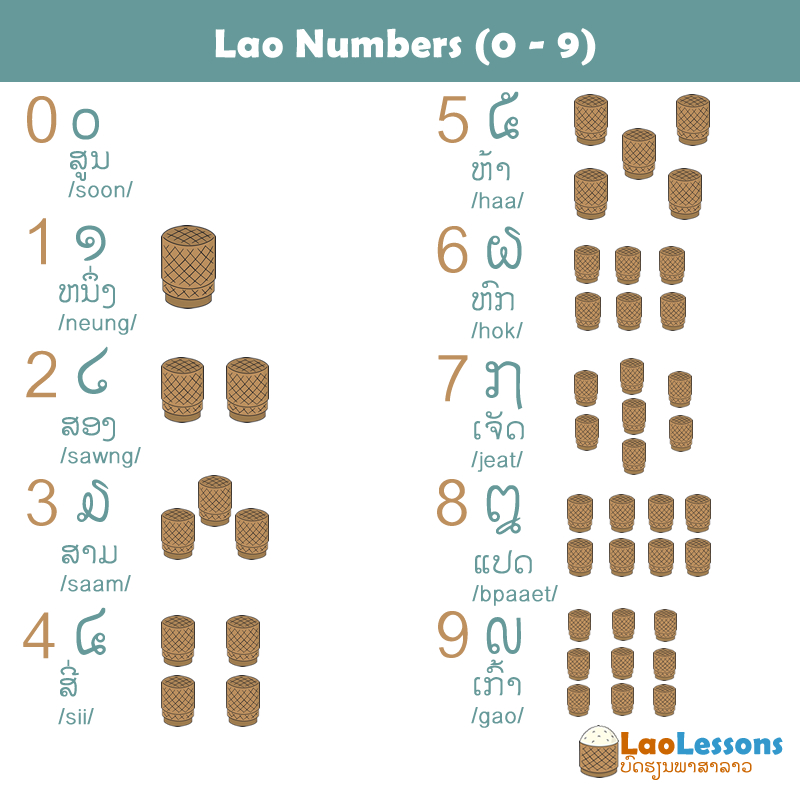Sam, song, neung, action!
This week we had two Lao lessons focusing on counting and forming sentences with basic vocabulary.
Counting in Lao
On Tuesday (August 29th) we learned how to count in Lao. Here are the numbers from 0 to 10:
- soun
- neung
- song
- sam
- see
- har
- hok
- chedt
- paedt
- gao
- sip
If you can count from 0 to 10 and know the words for hundred, thousand, hundred thousand, etc. you can count up to infinity in Lao. Counting in Lao is very manageable. Counting in Lao is different from other languages because Lao does not have separate names for words like “forty” or “ninety.” Instead, you say how many tens you have and then say how many ones.
For example: 43 = 4 tens and 3 ones. So that would be “see sip sam.”
The only number in the tens that differs is the number 20. 20 is “sao.” Everything else is regular and follows a set pattern of naming. If you want to form numbers in the thousands, hundreds of thousands, millions, or billions, you need to break the numbers down into smaller pieces and add these words after each respective category:
- hundred - haw
- thousand - panh
- hundred thousand - saen
- million - lahn
- billion - teu

Courtesy of Lao Lessons
Learning Lao Grammar
On Friday we learned about Lao verbs. We had already learned the personal pronouns during the previous week. Lao is a Subject-Verb-Object (SVO) language just like English.
For example: Khoi gin nam. (I drink water.) “I” = subject, “drink” = verb, “nam” = direct object
Read more about word order in world languages
Personal Pronouns
| Number of Persons | Singular | Plural |
|---|---|---|
| 1st person | khoi/ phuok khao (I/ more polite “I” used when presenting for a group) | pohk hao (we) |
| 2nd person | jao (you) | pohk jao (y’all) |
| 3rd person for people | lao (he/she) | pohk chao (“they” for people) |
| 3rd person for animals/objects | menh (it) | — (“they” for animals/objects) |
We learned how to create sentences using verbs and direct objects and how to structure a negative sentence. In Lao, there are no verb conjugations, no tenses, and no subject-verb agreement. You simply select a personal pronoun and a verb to create a statement in the present tense.
For example: Khoi hien. (I study.) Lao hien. (He/she studies.)
In Lao, the previous sentence has one form that can express 3 tenses in English:
- I study (present simple)
- I am studying (present progressive)
- I do study (present emphatic)
German also one (present tense) form that can express 3 tenses in English. Read more about the present tense in German
If you wanted to create a statement in the past you would add “lew” before the verb. To form the future tense you would add “si” or “cha” (more formal) before the verb.
For example: Lao lew hien yu hong hien. (He studied at school.) Lao si hien yu hong hien. (He will study at school.)
To create a negative statement you add “bohr” (“not”) after the subject pronoun and before the verb.
For example: Khoi bohr mak mak-appern. (I do not like apples.)
In addition, there are no cases in Lao and no definite (“the” is used to identify that the identity of the noun is known to the reader) or indefinite (“a” or “an” is used before a noun that is general or when the noun’s identity is not known) articles.
Discover more about cases
Read more about definite and indefinite articles
Khoi mak pha saa lao (I like Lao)
I felt like I was able to make a lot of progress over the course of these two classes. I can already form sentences and basic questions. Now I just need more vocabulary!